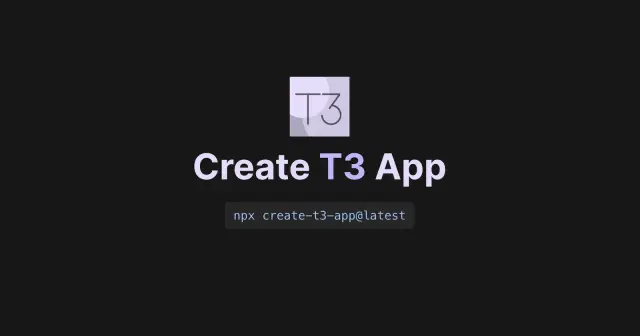
A First Look at create-t3-app
Published:
create-t3-app is a fullstack, typesafe React framework with Next.js, tRPC, Prisma, and Tailwind deployed on Vercel and Fly.
Outline
- Introduction
- Create t3 App
- Provision PostgreSQL Database
- Query Posts with tRPC
- Add Cells for Declarative Data Fetching
- Deployment
- Resources, Articles, and Videos
All of this project’s code can be found in the First Look monorepo on my GitHub.
Introduction
create-t3-app is a fullstack React framework and CLI that has emerged as an evolution of the T3 stack recommended on Theo Browne’s website init.tips. It’s described by its creators as “kind of a template,” which is meant to stress that it is “NOT a template”.
Why the t3 Stack Was Created
ct3a’s goal is to provide the quickest way to start a new fullstack, typesafe web application. To achieve this goal, the stack is architected around three foundational constituents that together can be bundled together and used to develop monolithic applications:
- Typed React frontend (TypeScript and Next.js)
- Typed database client (Prisma)
- Typed remote procedure calls (tRPC)
Depending on your background and perspective that may sound like a ground breaking innovation, a completely obvious repackaging of techniques used over two decades ago, or an absolute heresy because you’ve been taught that developing monoliths is a sin.
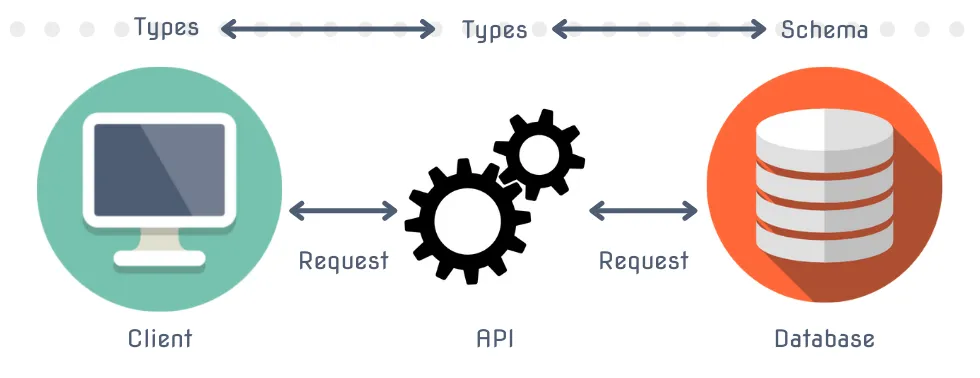
Source: Sabin Adams - End-To-End Type Safety
As someone who has resisted TypeScript until now, this is terrifying to me. But I’m going to make an exception and embrace TypeScript for the first time in my life if this stack can actually provide a smooth and streamlined TypeScript experience.
But for those already in love with TypeScript and fullstack React frameworks, you are probably feeling a strange sense of deja-vu right now. This is an almost identical stack to Blitz.js and shares many of the same architectural principles. The notable difference is that CTA includes tRPC (which itself has frequently been compared to Blitz.js).
History of the t3 Stack and Create Nex App
The first iteration of the init.tips site suggested only one command was needed to initialize a mostly optimal boilerplate for the majority of web applications in 2021. This suggestion (in its infinite wisdom) was: Create a Next.js app, but with TypeScript.

As people began to consider this advice, many developers inevitably asked:
“Mmmm, but what about all that other stuff not included in this stack that I need to make an even borderline functional application?”
This lead to other recommendations for add-ons to the stack. These add-ons targeted specific use cases such as:
- Prisma for managing database migrations and SQL queries through an ORM
- Next-auth for client side authentication
- Tailwind for CSS and UI styling
- tRPC for end-to-end typesafe APIs
If these were being frequently recommended, it stood to reason that it would make sense to create a new, more full featured command. This would generate not only a typed Next.js project, but one with an ORM, authentication, styling, and API protocol.
These would be automatically included while also giving you the ability to opt out if you still want the bare-bones version. I’m happy that this is taking off and that some consider it a novel idea.
I’ve spent the last two years relentlessly promoting frameworks assembling different versions of these kinds of stacks. RedwoodJS, Blitz.js, and Bison all have extremely similar but also slightly different stacks. To understand how these relate to each other, I would break it down like so:

This is not meant to be an exhaustive list and I’ve purposefully left off things like tests, mocks, Storybook, deployment, and other non-architectural pieces.
As the project has evolved from init.tips to create-t3-app, it has taken on a life of its own. Theo has stated numerous times that he did not actually initiate the creation of create-t3-app, he simply talked about the idea numerous times in public.
In fact, he never would have had the time to build or manage such a project. On top of full time content creation, he’s the CEO of a startup building ping.gg, a collaborative streaming tool. His influence over the project primarily stemmed from his various public discussions of the stack.
These discussions inspired a group of people who were members of his recently formed Discord server. This online space was created to bring together fans of his Twitch and YouTube channels. A group independently began building out a full fledged project. This activity was centered around the work of Shoubhit Dash.
Known as nexxel or nexxeln online, Shoubhit took the initiative to formalize the stack by developing an interactive CLI tool that would be able to scaffold out a project using arbitrary combinations of the various technologies used in the stack. nexxel, a 17 year old self-taught developer, is the true rosetta stone to this project.
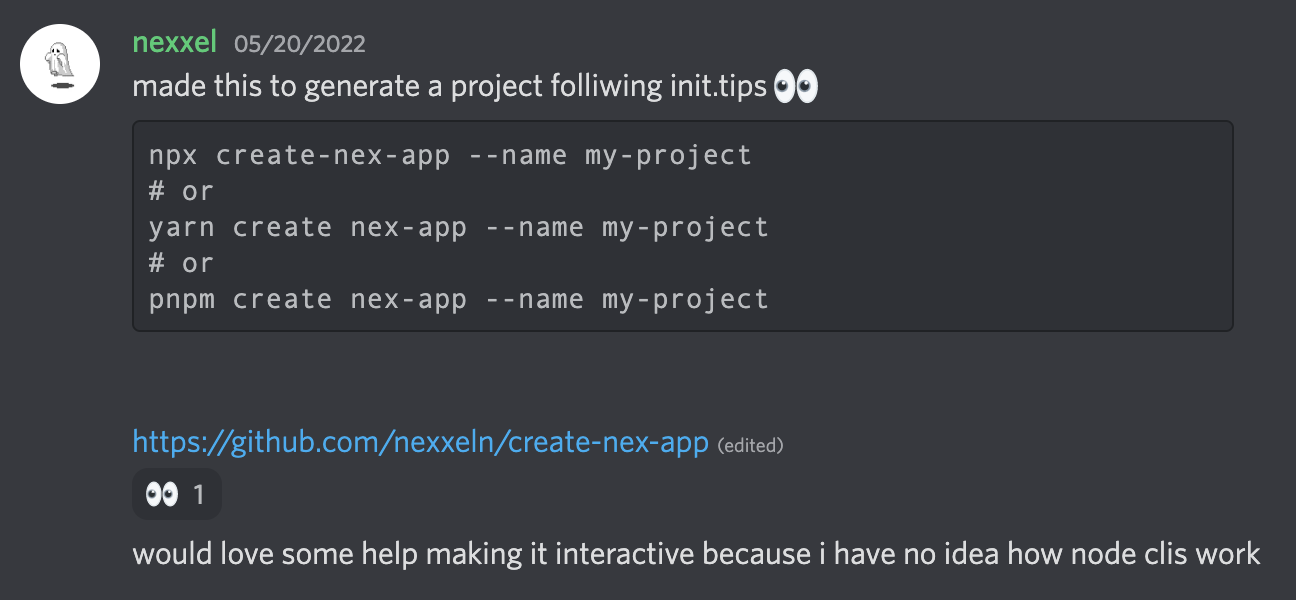
Nexxel was blogging about tRPC in May right before launching the framework. Build end to end typesafe APIs with tRPC signaled the birth of the framework on May 21, 2022 along with an initial commit on May 20, 2022. Originally called Create Nex App, the README described the project like so:
Scaffold a starting project using the t3 stack using this interactive CLI.
The early prototypes of the project included Next.js, Tailwind, and TypeScript along with tRPC. Throughout June, the project began attracting around a dozen contributors. Julius Marminge (juliusmarminge) was one of the earliest contributors and remains active today.
Roughly a month later on June 26, 2022, nexxel published T3 stack and my most popular open source project ever. This blog post was published after working with the other contributors to fully integrate Prisma and Next Auth, marking the completion of the stack’s initial integration phase.
Throughout the month of June, the GitHub repo gained nearly 2,000 GitHub stars. Despite having only been created at the end of May, the project had reached nearly unprecedented levels of momentum. On July 17, 2022, nexxel migrated his personal blog to create-t3-app and by the middle of August the project had over 5,000 stars.
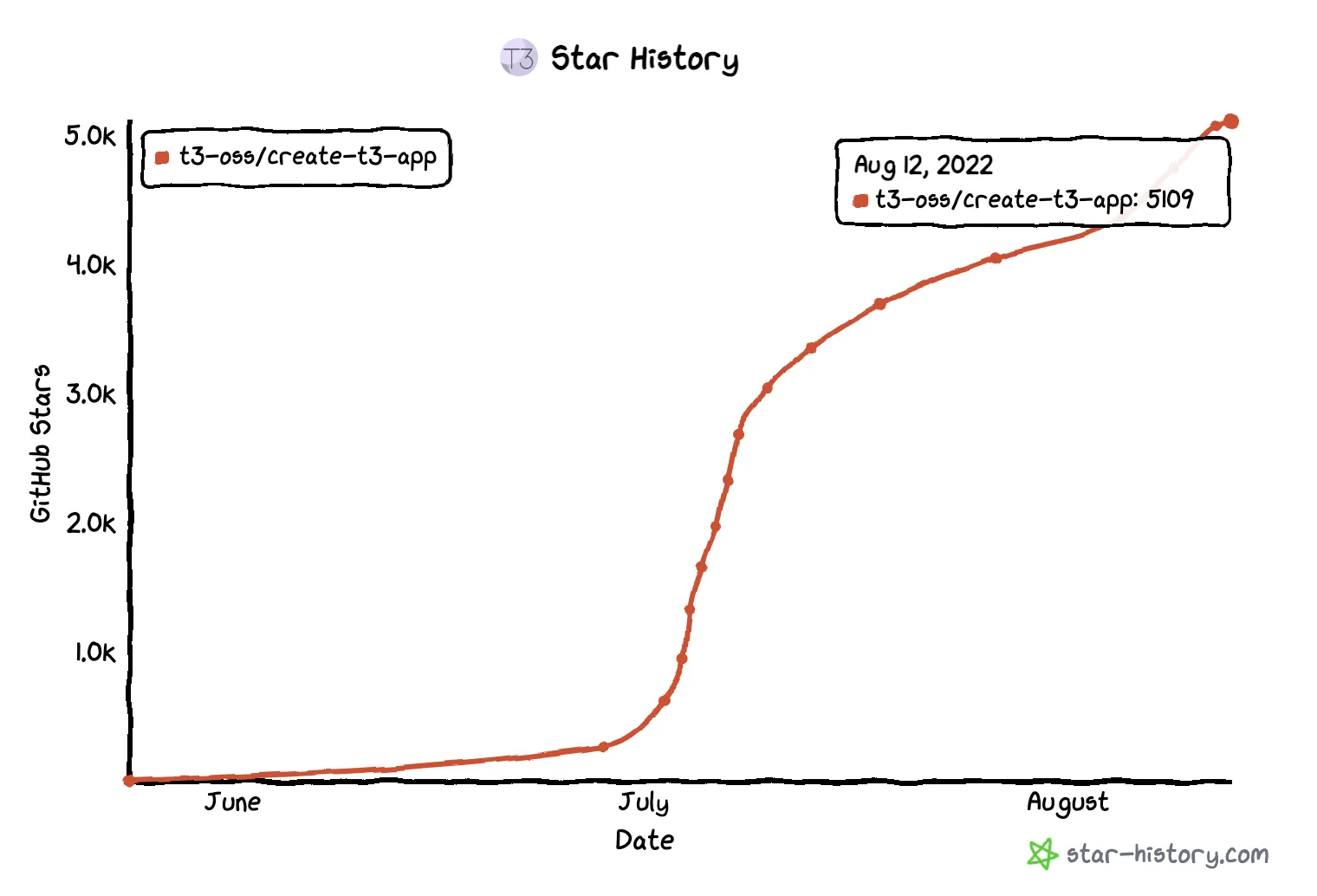
Create t3 App
To get started with ct3a, you can run any of the following three commands and answer the command prompt questions:
npx create-t3-app@latestyarn create t3-apppnpm dlx create-t3-app@latestThe following CLI options are currently available:
| Option | Description |
|---|---|
--noGit | Explicitly tell the CLI to not initialize a new git repo in the project |
-y, --default | Bypass CLI and use all default options to bootstrap new t3-app |
[dir] | Include a directory argument with a name for the project |
--noInstall | Generate project without installing dependencies |
We’ll give our project a name and select all available options with the exception of NextAuth.
pnpm dlx create-t3-app@latest ajcwebdev-t3I will select the following options:
? Will you be using JavaScript or TypeScript? TypeScript? Which packages would you like to enable? prisma, tailwind, trpc? Initialize a new git repository? Yes? Would you like us to run 'pnpm install'? YesIncluding the -y option will select the default configuration which bundles all four packages into the project. The interactive CLI prompt will also ask whether you want to use JavaScript or TypeScript. If you try to select JavaScript though, you will discover that the option is but a mere illusion. In fact, you must use TypeScript and also there is no God.
Using: pnpm
✔ ajcwebdev-t3 scaffolded successfully!
✔ Successfully setup boilerplate for prisma✔ Successfully setup boilerplate for tailwind✔ Successfully setup boilerplate for trpc✔ Successfully setup boilerplate for envVariables✔ Successfully installed dependencies!✔ Successfully initialized gitEnter your project directory and start the development server.
cd ajcwebdev-t3pnpm devOpen localhost:3000 to see the generated project.
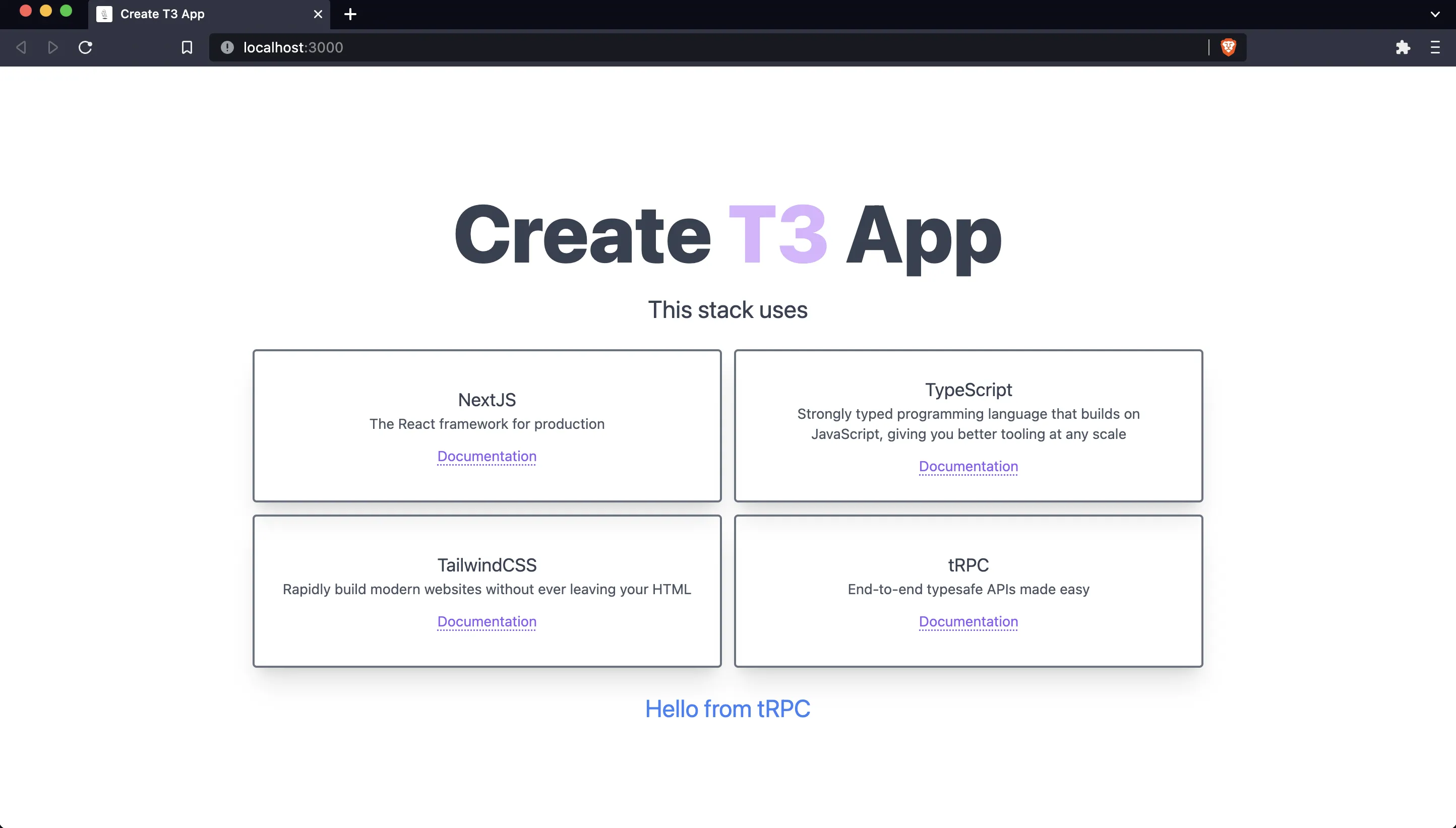
Project Structure
If we ignore the configuration files in the root of our project then our folder and file structure includes the following:
.├── prisma│ └── schema.prisma├── public│ └── favicon.ico└── src ├── env │ ├── client.mjs │ ├── schema.mjs │ └── server.mjs ├── pages │ ├── _app.tsx │ ├── api │ │ ├── examples.ts │ │ └── trpc │ │ └── [trpc].ts │ └── index.tsx ├── server │ ├── db │ │ └── client.ts │ └── trpc │ ├── context.ts │ ├── router │ │ ├── _app.ts │ │ └── example.ts │ └── trpc.ts ├── styles │ └── globals.css └── utils └── trpc.tsWe’ll break down each of these different directories and files as we progress through the tutorial. But as a quick overview, we’ll be primarily working with:
- Pages and API Routes
src/pages/index.tsxsrc/pages/api/examples.tssrc/pages/api/trpc/[trpc].ts
- Server and Database
src/server/db/client.tssrc/server/trpc/context.tssrc/server/trpc/router/_app.tssrc/server/trpc/router/example.tssrc/server/trpc/trpc.ts
- Styling
src/styles/globals.css
- Utilities
src/utils/trpc.ts
Tailwind Styles
Open src/pages/index.tsx and make some changes to customize the home page. Feel free to follow along or make your own alterations, there are many different ways this project could be organized. First, I will create a file called file called home-styles.ts to hold all styling that will be used on the home page of the website.
echo > src/styles/home-styles.tsI will export a variable defining each Tailwind style that can be reused throughout the project.
export const appContainer = "container mx-auto flex flex-col items-center justify-center min-h-screen p-4"export const title = "text-5xl md:text-[5rem] leading-normal font-extrabold text-gray-700"export const purple = "text-purple-300"export const body = "text-2xl text-gray-700"export const grid = "grid gap-3 pt-3 mt-3 text-center md:grid-cols-2 lg:w-2/3"export const queryResponse = "pt-6 text-2xl text-blue-500 flex justify-center items-center w-full"appContainerstyles themaincontenttitlestyles the page’sh1headerpurplestyles T3 with its signature purple colorbodystyles theptag introducing the list of technologies included in the stackgridstyles thedivwrapping theTechnologyCardcomponentsqueryResponsestyles thedivwrapping the tRPChelloquery
Add these style variables to the Home component.
import Head from "next/head"import { trpc } from "../utils/trpc"import { appContainer, title, purple, body, grid, queryResponse} from "../styles/home-styles"
export default function Home() { const hello = trpc.useQuery([ "example.hello", { text: "from tRPC" } ])
return ( <> <Head> <title>A First Look at create-t3-app</title> <meta name="description" content="Example t3 project from A First Look at create-t3-app" /> <link rel="icon" href="/favicon.ico" /> </Head>
<main className={appContainer}> <h1 className={title}> Create <span className={purple}>T3</span> App </h1>
<p className={body}>This stack uses:</p>
<div className={grid}>...</div> <div className={queryResponse}>...</div> </main> </> )}echo > src/styles/card-styles.tsAdd style variables to the TechnologyCard component:
cardSectionstyles the card’s container on thesectionelementcardTitlestyles the technology’s title on each cardcardDescriptionstyles the description of each technologylinkstyles the link on each card
export const cardSection = "flex flex-col justify-center p-6 duration-500 border-2 border-gray-500 rounded shadow-xl motion-safe:hover:scale-105"export const cardTitle = "text-lg text-gray-700"export const cardDescription = "text-sm text-gray-600"export const link = "mt-3 text-sm underline text-violet-500 decoration-dotted underline-offset-2"import Head from "next/head"import { trpc } from "../utils/trpc"import { appContainer, title, purple, body, grid, queryResponse } from "../styles/home-styles"import { cardSection, cardTitle, cardDescription, link } from "../styles/card-styles"
type TechnologyCardProps = {...}
const TechnologyCard = ({ name, description, documentation }: TechnologyCardProps) => { return ( <section className={cardSection}> <h2 className={cardTitle}> {name} </h2>
<p className={cardDescription}> {description} </p>
<a className={link} href={documentation} target="_blank" rel="noreferrer"> Documentation </a> </section> )}Now I will modify the four cards to include links to my blog and social media profiles. With that change in mind, I will use url instead of documentation for a more appropriate prop name. I will also change the links to include the entire card within the anchor tags so clicking anywhere on the card will open the hyperlink.
import Head from "next/head"import { trpc } from "../utils/trpc"import { appContainer, title, purple, body, grid, queryResponse, cardSection, cardTitle, cardDescription, link} from "../styles/home-styles"
type TechnologyCardProps = { name: string url: string}
const TechnologyCard = ({ name, url }: TechnologyCardProps) => { return ( <a href={`https://${url}`} target="_blank" rel="noreferrer"> <section className={cardSection}> <h2 className={cardTitle}> {name} </h2>
<span className={link}> {url} </span> </section> </a> )}
export default function Home() { const hello = trpc.useQuery([ "example.hello", { text: "from tRPC" } ])
return ( <> <Head> <title>A First Look at create-t3-app</title> <meta name="description" content="Example t3 project from A First Look at create-t3-app" /> <link rel="icon" href="/favicon.ico" /> </Head>
<main className={appContainer}> <h1 className={title}> Hello from <span className={purple}>ajc</span>webdev </h1>
<div className={grid}> <TechnologyCard name="Blog" url="ajcwebdev.com/" /> <TechnologyCard name="Twitter" url="twitter.com/ajcwebdev/" /> <TechnologyCard name="GitHub" url="github.com/ajcwebdev/" /> <TechnologyCard name="Polywork" url="poly.work/ajcwebdev/" /> </div>
<div className={queryResponse}> { hello.data ? <p>{hello.data.greeting}</p> : <p>Loading..</p> } </div> </main> </> )}Return to localhost:3000 to see the changes.
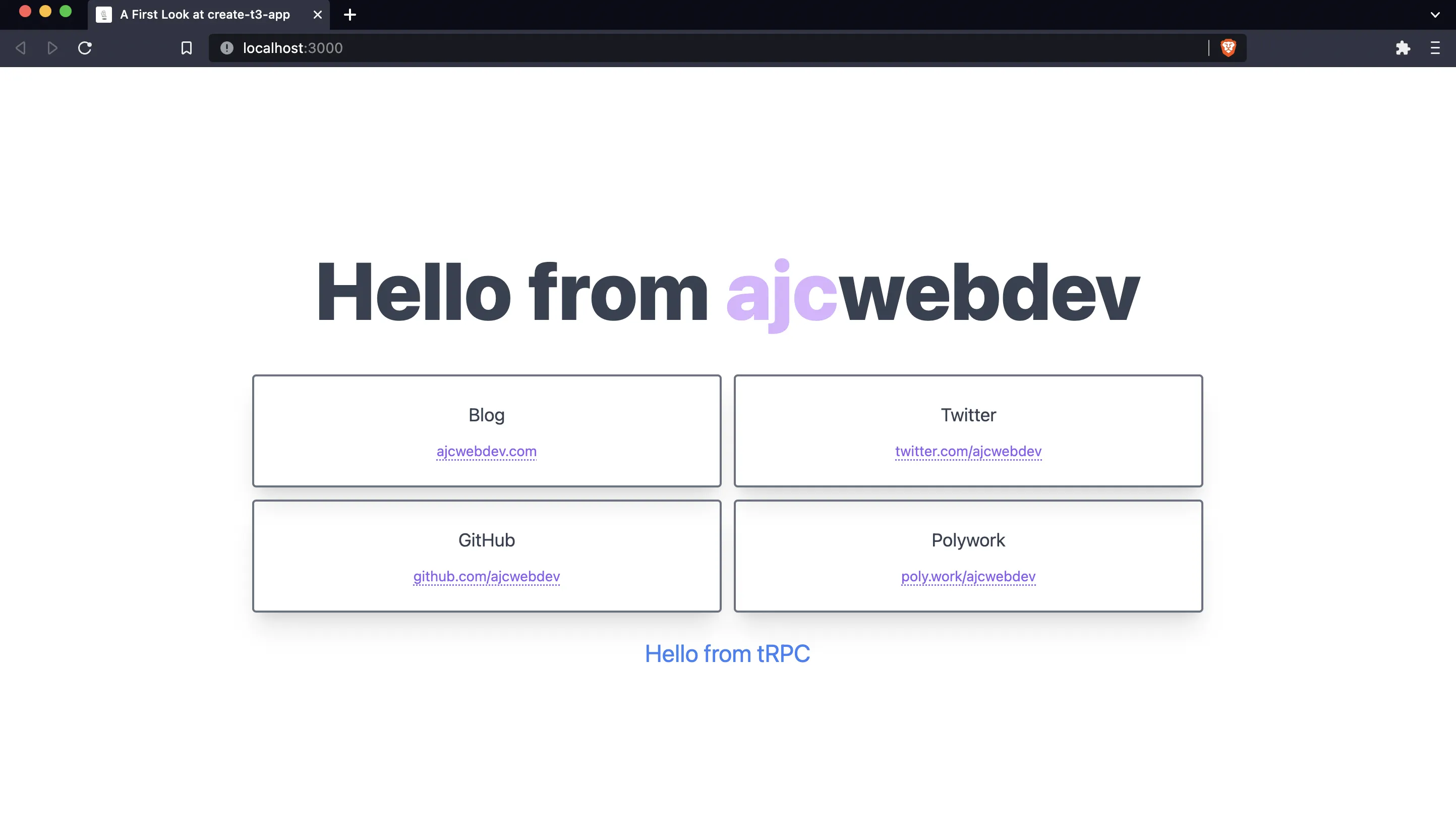
Lastly, I will abstract out the TechnologyCard component into its own file and rename it to Card.
mkdir src/componentsecho > src/components/Card.tsxRename TechnologyCardProps to CardProps and create a Card component.
import { cardSection, cardTitle, link } from "../styles/home-styles"
type CardProps = { name: string url: string}
export default function Card({ name, url}: CardProps) { return ( <a href={`https://${url}`} target="_blank" rel="noreferrer"> <section className={cardSection}> <h2 className={cardTitle}> {name} </h2>
<span className={link}> {url} </span> </section> </a> )}Import Card into src/pages/index.tsx and remove CardProps.
import Head from "next/head"import Card from "../components/Card"import { appContainer, title, purple, grid } from "../styles/home-styles"
export default function Home() { return ( <> <Head> <title>A First Look at create-t3-app</title> <meta name="description" content="Example t3 project from A First Look at create-t3-app" /> <link rel="icon" href="/favicon.ico" /> </Head>
<main className={appContainer}> <h1 className={title}> Hello from <span className={purple}>ajc</span>webdev </h1>
<div className={grid}> <Card name="Blog" url="ajcwebdev.com/" /> <Card name="Twitter" url="twitter.com/ajcwebdev/" /> <Card name="GitHub" url="github.com/ajcwebdev/" /> <Card name="Polywork" url="poly.work/ajcwebdev/" /> </div> </main> </> )}Provision PostgreSQL Database
Since this a fullstack framework, it already includes a tool called Prisma for working with our database. Our models will be defined in the prisma/schema.prisma file along with our specific database provider.
Add Posts Model to Prisma Schema
The initial generated project has the database datasource set to SQLite. Since we want to use a real database, open schema.prisma and update the datasource to the PostgreSQL provider.
generator client { provider = "prisma-client-js"}
datasource db { provider = "postgresql" url = env("DATABASE_URL")}In addition to the current models in the schema, add a Post model with an id, title, description, body, and createdAt timestamp.
model Post { id String @id title String description String body String createdAt DateTime @default(now())}Also, uncomment all appearances of @db.Text on the Account model.
model Account { id String @id @default(cuid()) userId String type String provider String providerAccountId String refresh_token String? @db.Text access_token String? @db.Text expires_at Int? token_type String? scope String? id_token String? @db.Text session_state String? user User @relation(fields: [userId], references: [id], onDelete: Cascade)
@@unique([provider, providerAccountId])}Initialize Railway Database and Run Migration
We’ll use Railway to provision a PostgreSQL database. First, you need to create a Railway account and install the Railway CLI. If you are unable to login through the browser, run railway login --browserless instead.
railway loginRun the following command, select “Empty Project,” and give your project a name.
railway initTo provision the database, add a plugin to your Railway project and select PostgreSQL.
railway addSet the DATABASE_URL environment variable for your database and create a .env file to hold it.
echo DATABASE_URL=`railway variables get DATABASE_URL` > .envRun a migration with prisma migrate dev to generate the folders and files necessary to create a new migration. We’ll name our migration init with the --name argument.
pnpm prisma migrate dev --name initAfter the migration is complete, generate the Prisma client with prisma generate.
pnpm prisma generateSeed a Blog Post
Right now we’ll avoid implementing an endpoint through our app with write, update, or delete functionality since we’ll not be including authentication in this section. However, there are at least five different ways you can write data to your database. If you want to skip this section, the tl;dr is send raw SQL queries through the Railway Query dashboard.
The Railway dashboard provides three separate methods for accessing your database (not including using the connection string itself as an environment variable in the project as we’ll do later):
- Execute raw SQL queries under the Query tab
- Connect to database with the
psqlcommand under the Connect tab - Enter data with Railway’s UI under the Data tab
For Prisma, you can either:
- Login to the Prisma Data Platform at cloud.prisma.io
- Run Prisma Studio on localhost 5555 with
pnpm prisma studio
Note: I’m including Prisma Studio here for completion’s sake, but I advise against using it. It’s a seemingly sleek and polished product with a very strange input bug that causes it to throw out a value if you don’t click away from the input before adding the record to the table. This means you can create a record and have a crucial field get totally wiped and replaced with a blank value.
Yes, this is should just be for a test database, and yes it’s just dummy data. But still, to me, especially for a database tool, this seems fundamentally broken and I honestly can’t recommend using this tool in good conscious. I first experienced this bug around the end of 2021 and you can view a recording of the bug in action on an episode of Teach Jenn Tech recorded in November 2022.
GUIs are more intuitive for developers without much SQL experience. But unfortunately, they can also be buggy or cumbersome. You especially don’t want to be entering every row by hand when you need to input large amounts of data at once. SQL commands provide a more consistent and scalable technique for seeding a database or entering ongoing new data.
The first option on the list (execute raw SQL queries under the Query tab on Railway’s dashboard) gives us the best of both worlds. It does not require entering data into any GUI but it also does not require installing a Postgres client like psql to your local machine and connecting to a database instance over the network. We could create a blog post with the following command:
INSERT INTO "Post" (id, title, description, body) VALUES ( '1', 'A Blog Post Title', 'This is the description of a blog post', 'The body of the blog post is here. It is a very good blog post.');This SQL command can be entered directly into the text area under the Query tab.

Click “Run query” and then add two more blog posts:
INSERT INTO "Post" (id, title, description, body) VALUES ( '2', 'Second Blog Post', 'This is the description of ANOTHER blog post', 'Even better than the last!');INSERT INTO "Post" (id, title, description, body) VALUES ( '3', 'The Final Blog Post', 'This is the description for my final blog post', 'My blogging career is over. This is the end, thank you.');Query Posts with tRPC
tRPC is a library that is designed for writing typesafe APIs. Instead of importing server code, the client only imports a single TypeScript type. tRPC transforms this type into a fully typesafe client that can be called from the frontend.
Create Post Router
Create a file to initialize a router instance called postRouter. This will query for all of our posts.
echo > src/server/router/post.tsAdd a query endpoint to the router with the .query() method. It with accept two arguments: name for the name of the endpoint and params for query parameters.
import { createRouter } from "./context"
export const postRouter = createRouter() .query('all', { async resolve() { // Add Prisma query }, })params.resolve implements the endpoint which will be a function with a single req argument that runs the Prisma Client findMany query which returns a list of records, in this case all posts based on the post model.
import { prisma } from "../db/client"import { createRouter } from "./context"
export const postRouter = createRouter() .query('all', { async resolve() { return prisma.post.findMany() }, })params.input provides input validation and will be discussed in the Create Default Query Cell section.
Create App Router
In src/server/router/index.ts, there is a base appRouter for our server entry point. This can be gradually extended with more types and resolved into a single object.
import superjson from "superjson"import { createRouter } from "./context"import { exampleRouter } from "./example"import { protectedExampleRouter } from "./protected-example-router"
export const appRouter = createRouter() .transformer(superjson) .merge("example.", exampleRouter) .merge("question.", protectedExampleRouter)
export type AppRouter = typeof appRouterImport postRouter and use the .merge() method to combine the following three routes into a single appRouter instance:
exampleRouterpostRouterprotectedExampleRouter
import superjson from "superjson"import { createRouter } from "./context"import { exampleRouter } from "./example"import { postRouter } from "./post"import { protectedExampleRouter } from "./protected-example-router"
export const appRouter = createRouter() .transformer(superjson) .merge("example.", exampleRouter) .merge("post.", postRouter) .merge("question.", protectedExampleRouter)
export type AppRouter = typeof appRouterQueries related to blog posts will be prefixed with post (post.all, post.byId). The hello query example will be prefixed with example as seen earlier with example.hello.
Query Posts with useQuery
Open src/pages/index.tsx to query all posts and display them on the home page. Create a Posts component and initialize a variable called postsQuery above the return statement. Set the postsQuery variable to the output of post.all with the useQuery() hook.
import Head from "next/head"import { trpc } from "../utils/trpc"import { appContainer, title, purple, body, grid, queryResponse, cardSection, cardTitle, cardDescription, link} from "../styles/home-styles"import Card from "../components/Card"
const Posts = () => { const postsQuery = trpc.useQuery([ 'post.all' ])
return (...)}
export default function Home() {...}As mentioned in the previous section, the appRouter object can be inferred on the client. Stringify the JSON output from postsQuery.data and display the data below the title of the page.
const Posts = () => { const postsQuery = trpc.useQuery([ 'post.all' ])
const { data } = postsQuery
return ( <div className={queryResponse}> {data ? <p>{JSON.stringify(data)}</p> : <p>Loading..</p> } </div> )}Return Posts in the Home component.
export default function Home() { return ( <> <Head> <title>A First Look at create-t3-app</title> <meta name="description" content="Example t3 project from A First Look at create-t3-app" /> <link rel="icon" href="/favicon.ico" /> </Head>
<main className={appContainer}> <h1 className={title}> Hello from <span className={purple}>ajc</span>webdev </h1>
<div className={grid}> <Card name="Blog" url="ajcwebdev.com/" /> <Card name="Twitter" url="twitter.com/ajcwebdev/" /> <Card name="GitHub" url="github.com/ajcwebdev/" /> <Card name="Polywork" url="poly.work/ajcwebdev/" /> </div>
<Posts /> </main> </> )}
We have some conditional logic to ensure that a loading message is displayed if the data has not yet returned from the server. But what if there are no blog posts in the database or the server returns an error? This is a case that would be perfectly suited for a Cell.
Add Cells for Declarative Data Fetching
One of my favorite patterns from Redwood that I have been hoping to see in other frameworks is the concept of a Cell. Cells provide a built-in convention for declarative data fetching that isn’t exactly a state machine but shares common benefits and characteristics.
Unlike general purpose finite-state machines, Cells are specifically focused on common data fetching outcomes. They give developers the ability to avoid writing any conditional logic since a cell will manage what happens during the following four potential states of your data fetching:
- Success - Display the response data
- Failure - Handle the error message and provide instructions to the user
- Empty - Show a message or graphic communicating an empty list
- Loading - Show a message or graphic communicating the data is still loading
Thankfully, my hopes were fulfilled when lead tRPC maintainer, Alex Johansson opened a PR with a tRPC Cell example that he acknowledged was influenced by RedwoodJS.
Create Default Query Cell
createQueryCell is used to bootstrap DefaultQueryCell which can be used anywhere in your application.
echo > src/utils/DefaultQueryCell.tsxIdeally this will one day be internal to either tRPC or create-t3-app and you’ll be able to just write cells without thinking about it. But for now, we need to create this ourselves.
import { TRPCClientErrorLike } from "@trpc/client"import NextError from "next/error"import type { AppRouter } from "../server/router/index"import { QueryObserverIdleResult, QueryObserverLoadingErrorResult, QueryObserverLoadingResult, QueryObserverRefetchErrorResult, QueryObserverSuccessResult, UseQueryResult,} from "react-query"
type JSXElementOrNull = JSX.Element | null
type ErrorResult<TData, TError> = | QueryObserverLoadingErrorResult<TData, TError> | QueryObserverRefetchErrorResult<TData, TError>
interface CreateQueryCellOptions<TError> { error: (query: ErrorResult<unknown, TError>) => JSXElementOrNull loading: (query: QueryObserverLoadingResult<unknown, TError>) => JSXElementOrNull idle: (query: QueryObserverIdleResult<unknown, TError>) => JSXElementOrNull}
interface QueryCellOptions<TData, TError> { query: UseQueryResult<TData, TError> error?: (query: ErrorResult<TData, TError>) => JSXElementOrNull loading?: (query: QueryObserverLoadingResult<TData, TError>) => JSXElementOrNull idle?: (query: QueryObserverIdleResult<TData, TError>) => JSXElementOrNull}
interface QueryCellOptionsWithEmpty<TData, TError> extends QueryCellOptions<TData, TError> { success: (query: QueryObserverSuccessResult<NonNullable<TData>, TError>) => JSXElementOrNull empty: (query: QueryObserverSuccessResult<TData, TError>) => JSXElementOrNull}interface QueryCellOptionsNoEmpty<TData, TError> extends QueryCellOptions<TData, TError> { success: (query: QueryObserverSuccessResult<TData, TError>) => JSXElementOrNull}
function createQueryCell<TError>( queryCellOpts: CreateQueryCellOptions<TError>,) { function QueryCell<TData>(opts: QueryCellOptionsWithEmpty<TData, TError>): JSXElementOrNull function QueryCell<TData>(opts: QueryCellOptionsNoEmpty<TData, TError>): JSXElementOrNull function QueryCell<TData>(opts: | QueryCellOptionsNoEmpty<TData, TError> | QueryCellOptionsWithEmpty<TData, TError>, ) { const { query } = opts
if (query.status === 'success') { if ('empty' in opts && (query.data == null || (Array.isArray(query.data) && query.data.length === 0)) ) { return opts.empty(query) } return opts.success(query as QueryObserverSuccessResult<NonNullable<TData>, TError>) }
if (query.status === 'error') { return opts.error?.(query) ?? queryCellOpts.error(query) } if (query.status === 'loading') { return opts.loading?.(query) ?? queryCellOpts.loading(query) } if (query.status === 'idle') { return opts.idle?.(query) ?? queryCellOpts.idle(query) } return null } return QueryCell}
type TError = TRPCClientErrorLike<AppRouter>
export const DefaultQueryCell = createQueryCell<TError>({ error: (result) => ( <NextError title={result.error.message} statusCode={result.error.data?.httpStatus ?? 500} /> ), idle: () => <div>Loading...</div>, loading: () => <div>Loading...</div>,})We want to be able to query an individual blog post based on its id. Create a post page with a dynamic route based on the id.
mkdir src/pages/postecho > src/pages/post/\[id\].tsxSince we’ll be sending data to the database, we need to validate the input. zod is a TypeScript schema validator with static type inference. We’ll also import TRPCError for error handling.
import { prisma } from "../db/client"import { TRPCError } from "@trpc/server"import { z } from "zod"import { createRouter } from "./context"
export const postRouter = createRouter() .query('all', { async resolve() { return prisma.post.findMany() } })Add byId query to Post router in src/server/router/post.ts and destructure the id from the input.
import { prisma } from "../db/client"import { TRPCError } from "@trpc/server"import { z } from "zod"import { createRouter } from "./context"
export const postRouter = createRouter() .query('all', { async resolve() { return prisma.post.findMany() } })
.query('byId', { input: z.object({ id: z.string() }), async resolve({ input }) { const { id } = input }, })findUnique query lets you retrieve a single database record based on the id provided by passing it to Prisma’s where option.
import { prisma } from "../db/client"import { TRPCError } from "@trpc/server"import { z } from "zod"import { createRouter } from "./context"
export const postRouter = createRouter() .query('all', { async resolve() { return prisma.post.findMany() } })
.query('byId', { input: z.object({ id: z.string() }), async resolve({ input }) { const { id } = input const post = await prisma.post.findUnique({ where: { id } }) }, })Last but not least, throw an error with TRPCError if a post is not returned.
import { prisma } from "../db/client"import { TRPCError } from "@trpc/server"import { z } from "zod"import { createRouter } from "./context"
export const postRouter = createRouter() .query('all', { async resolve() { return prisma.post.findMany() } })
.query('byId', { input: z.object({ id: z.string() }), async resolve({ input }) { const { id } = input const post = await prisma.post.findUnique({ where: { id } }) if (!post) { throw new TRPCError({ code: 'NOT_FOUND', message: `No post with id '${id}'` }) } return post } })Create Post Page
Import DefaultQueryCell in src/pages/post/[id].tsx and create a component called PostPage.
import { useRouter } from "next/router"import Head from "next/head"import { DefaultQueryCell } from "../../utils/DefaultQueryCell"import { trpc } from "../../utils/trpc"
export default function PostPage() { return (...)}Return DefaultQueryCell and pass postQuery to query and data to success.
import { useRouter } from "next/router"import Head from "next/head"import { DefaultQueryCell } from "../../utils/DefaultQueryCell"import { trpc } from "../../utils/trpc"
export default function PostPage() { const id = useRouter().query.id as string const postQuery = trpc.useQuery([ 'post.byId', { id } ])
return ( <DefaultQueryCell query={postQuery} success={({ data }) => ( <> <Head> <title>{data.title}</title> <meta name="description" content={data.description} /> </Head>
<main> <h1>{data.title}</h1> <p>{data.body}</p> <em>Created {data.createdAt.toLocaleDateString()}</em> </main> </> )} /> )}Lastly, add blogContainer, blogTitle, and blogBody for styling the posts.
import { useRouter } from "next/router"import Head from "next/head"import { DefaultQueryCell } from "../../utils/DefaultQueryCell"import { trpc } from "../../utils/trpc"import { blogContainer, blogTitle, blogBody } from "../../styles/blog-styles"
export default function PostPage() { const id = useRouter().query.id as string const postQuery = trpc.useQuery([ 'post.byId', { id } ])
return ( <DefaultQueryCell query={postQuery} success={({ data }) => ( <> <Head> <title>{data.title}</title> <meta name="description" content={data.description} /> </Head>
<main className={blogContainer}> <h1 className={blogTitle}> {data.title} </h1> <p className={blogBody}> {data.body} </p>
<em>Created {data.createdAt.toLocaleDateString()}</em> </main> </> )} /> )}Open localhost:3000/post/1 to see your first blog post.

Create Posts Cell
echo > src/components/PostsCell.tsxecho > src/styles/blog-styles.tsexport const blogContainer = "container mx-auto min-h-screen p-4"export const blogTitle = "text-5xl leading-normal font-extrabold text-gray-700"export const blogBody = "mb-2 text-lg text-gray-700"export const blogHeader = "text-5xl leading-normal font-extrabold text-gray-700"Create a PostsCell function and import the following above it:
Linkfor linking to each blog post’s pageblogHeaderandlinkfor styling the list output from the CellDefaultQueryCellfor creating the celltrpcfor executing the query
import Link from "next/link"import { blogHeader, link } from "../styles/blog-styles"import { DefaultQueryCell } from "../utils/DefaultQueryCell"import { trpc } from "../utils/trpc"
export default function PostsCell() { return (...)}Create a type called BlogPostProps with an id and title of type string. Delete the Posts component in src/pages/index.tsx and move the useQuery hook into the PostsCell component.
import Link from "next/link"import { blogHeader, link } from "../styles/blog-styles"import { DefaultQueryCell } from "../utils/DefaultQueryCell"import { trpc } from "../utils/trpc"
type BlogPostProps = { id: string title: string}
export default function PostsCell() { const postsQuery = trpc.useQuery([ 'post.all' ])
return (...)}Return DefaultQueryCell with the query set to postsQuery. success will map over the data object and display a link for each blog post.
import Link from "next/link"import { blogHeader, link } from "../styles/blog-styles"import { DefaultQueryCell } from "../utils/DefaultQueryCell"import { trpc } from "../utils/trpc"
type BlogPostProps = { id: string title: string}
export default function PostsCell() { const postsQuery = trpc.useQuery([ 'post.all' ])
return ( <> <h2 className={blogHeader}>Posts</h2>
{postsQuery.status === 'loading'}
<DefaultQueryCell query={postsQuery} success={({ data }: any) => ( data.map(({id, title}: BlogPostProps) => ( <Link key={id} href={`/post/${id}`}> <p className={link}> {title} </p> </Link> )) )} empty={() => <p>WE NEED POSTS!!!</p>} /> </> )}Import PostsCell in src/pages/index.tsx and return the component in the Home function.
import Head from "next/head"import { appContainer, title, purple, grid } from "../styles/home-styles"import Card from "../components/Card"import PostsCell from "../components/PostsCell"
export default function Home() { return ( <> <Head> <title>A First Look at create-t3-app</title> <meta name="description" content="Example t3 project from A First Look at create-t3-app" /> <link rel="icon" href="/favicon.ico" /> </Head>
<main className={appContainer}> <h1 className={title}> Hello from <span className={purple}>ajc</span>webdev </h1>
<div className={grid}> <Card name="Blog" url="ajcwebdev.com/" /> <Card name="Twitter" url="twitter.com/ajcwebdev/" /> <Card name="GitHub" url="github.com/ajcwebdev/" /> <Card name="Polywork" url="poly.work/ajcwebdev/" /> </div>
<PostsCell /> </main> </> )}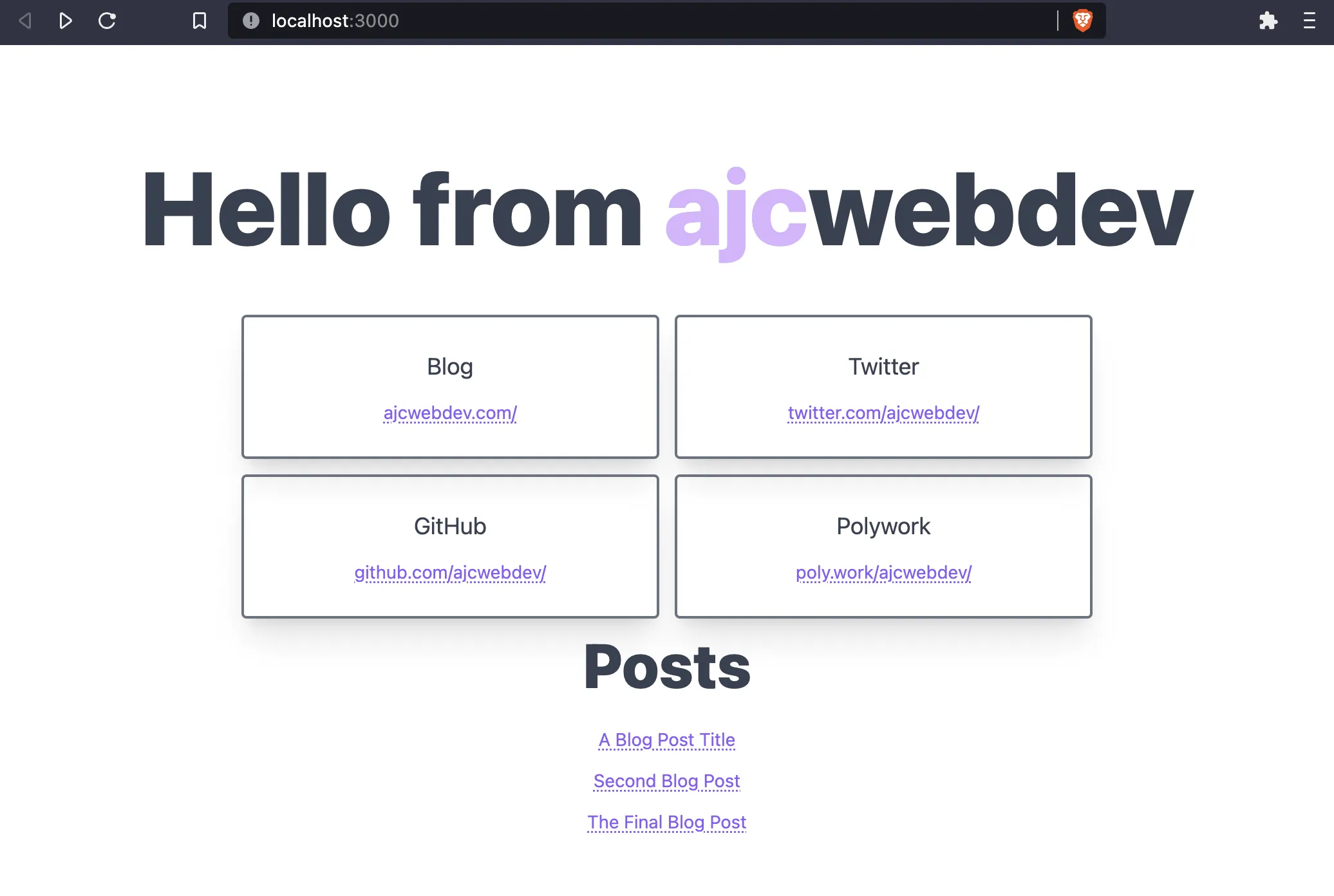
Deployment
Commit your current changes and create a new repository on GitHub with the GitHub CLI.
git add .git commit -m "ct3a"gh repo create ajcwebdev-t3 --public --push \ --source=. \ --description="An example T3 application with Next.js, Prisma, tRPC, and Tailwind deployed on Vercel and Fly." \ --remote=upstreamDeploy to Vercel
Install the vercel CLI on your machine or add it to your project with pnpm.
pnpm add -D vercelUse the following command to pass your database environment variable and deploy to Vercel. Use --confirm to give the default answer for each question.
pnpm vercel --env DATABASE_URL=YOUR_URL_HEREAfter the first deployment this command will deploy to a preview branch. You will need to include
--prodto push changes directly to the live site for future deployments.
Open ajcwebdev-t3.vercel.app to see your blog.

API endpoints are exposed on api/trpc/, so ajcwebdev-t3.vercel.app/api/trpc/post.all will display all blog posts.
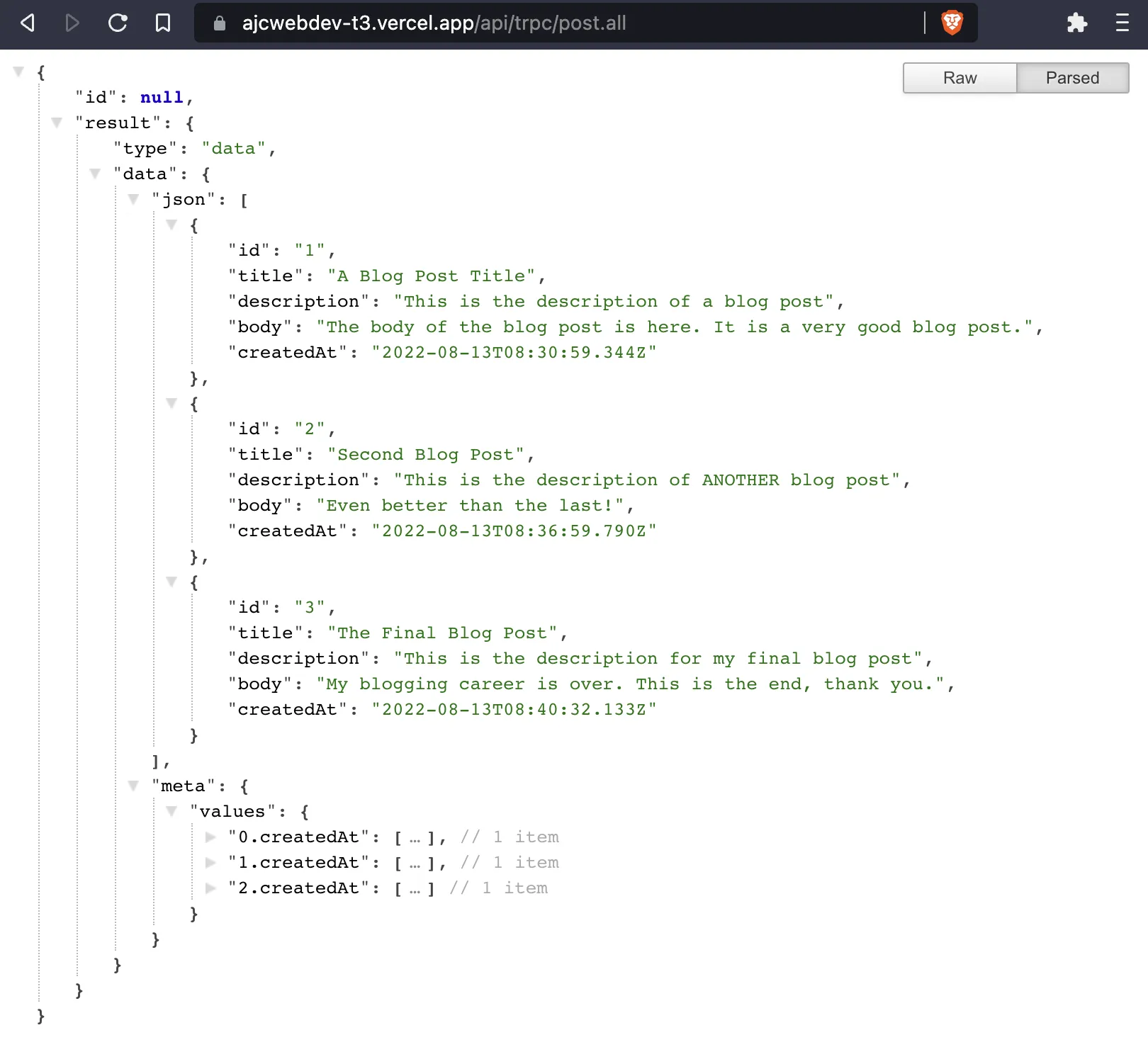
Or you can hit the endpoint with curl:
curl "https://ajcwebdev-t3.vercel.app/api/trpc/post.all" | npx json{ "id": null, "result": { "type": "data", "data": { "json": [ { "id": "1", "title": "A Blog Post Title", "description": "This is the description of a blog post", "body": "The body of the blog post is here. It is a very good blog post.", "createdAt": "2022-08-13T08:30:59.344Z" }, { "id": "2", "title": "Second Blog Post", "description": "This is the description of ANOTHER blog post", "body": "Even better than the last!", "createdAt": "2022-08-13T08:36:59.790Z" }, { "id": "3", "title": "The Final Blog Post", "description": "This is the description for my final blog post", "body": "My blogging career is over. This is the end, thank you.", "createdAt": "2022-08-13T08:40:32.133Z" } ], "meta": { "values": {...} } } }}For single blog posts try any of the following:
%7B%220%22%3A%7B%22json%22%3A%7B%22id%22%3A%221%22%7D%7D%7D%7B%220%22%3A%7B%22json%22%3A%7B%22id%22%3A%222%22%7D%7D%7D%7B%220%22%3A%7B%22json%22%3A%7B%22id%22%3A%223%22%7D%7D%7D
And copy them to the end of:
https://ajcwebdev-t3.vercel.app/api/trpc/post.byId?batch=1&input=
Check PageSpeed Insights for Desktop.
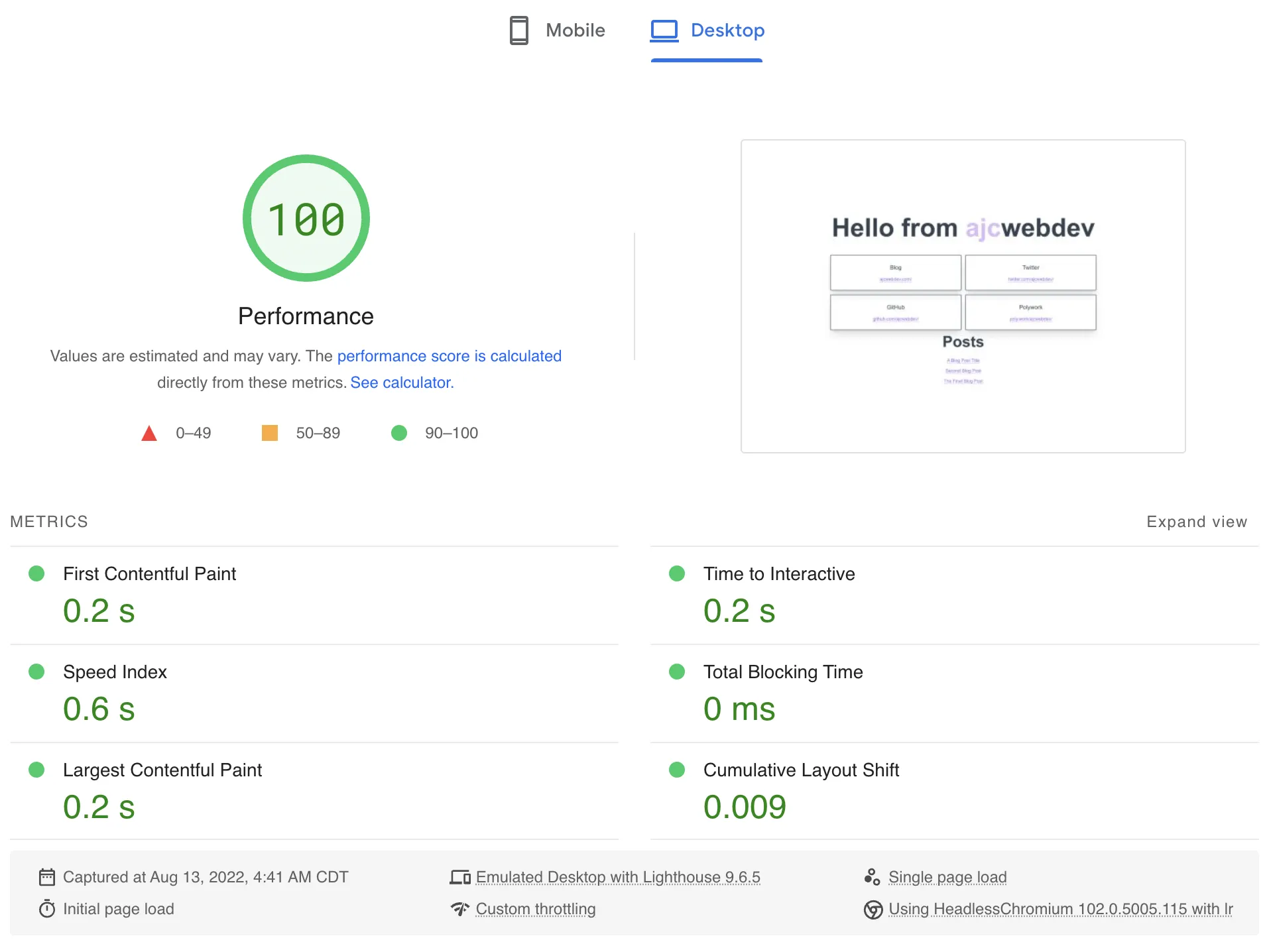
If what I know about these metrics is correct, then I believe 100 is considered a preferable score when compared to other scores which are not 100. PageSpeed Insights also gives a score for Mobile.

100 again! Equally as preferable!!
Deploy to Fly
Since create-t3-app is mostly Next.js and Prisma at the end of the day, it can be deployed very easily on platforms like Vercel. But, in return for that ease of use, you will be taking a performance hit whenever your database is queried.
When Prisma is running in a Lambda function it has a noticeable cold start. Future guides in the ct3a documentation will demonstrate how to use platforms like Fly, Railway, and Render to deploy your project to a long running server. Install the flyctl CLI and run the following command to initialize your project.
fly launch --remote-only \ --name ajcwebdev-t3 \ --region ord \ --env DATABASE_URL=YOUR_URL_HEREflyctl platform regions to see available regions.
Resources, Articles, and Videos
| Date | Title |
|---|---|
| 2022-08-10 | Build a full stack app with create-t3-app |
| 2022-07-10 | ct3a End to End Tutorial Proposal |
| 2022-06-26 | T3 stack and my most popular open source project ever |
| 2022-05-21 | Build end to end typesafe APIs with tRPC |
| Date | Title |
|---|---|
| 2022-07-17 | Build a Live Chat Application with the T3 Stack |
| 2022-07-12 | The T3 Stack - How We Built It |
| 2022-07-10 | An Overview of the create T3 App |
| 2022-07-03 | The BEST Stack For Your Next Project |
| 2022-06-28 | Build a Blog With the T3 Stack |